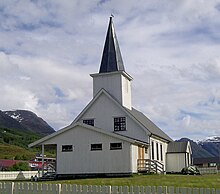Birtavarre
| Birtavarre | ||||
|---|---|---|---|---|
|
||||
| Basic data | ||||
| Country | Norway | |||
| Province (fylke) | Troms and Finnmark | |||
| Municipality (commune) : | Kåfjord | |||
| Coordinates : | 69 ° 30 ′ N , 20 ° 50 ′ E | |||
| Residents : | 231 (2003) | |||
| Area : | 0.35 km² | |||
| Population density : | 660 inhabitants per km² | |||
Birtavarre (or Kåfjordbotn or Kven Pirttivaara or North Sami Gáivuonbahta ) is a "Tettsted" in the municipality of Kåfjord in Troms og Finnmark in Norway .
Birtavarre is one of three places in the municipality and is home to the health services ( Norwegian helsetjenester ) for Kåfjords helsesenter . The place has a well-developed range of services, including shops, a gas station, a workshop, a tool shop ( Norwegian husflidutsalg ), a hairdresser and a campsite with huts . The place also has a wool mill that spins unwashed wool using machines from the beginning of the 20th century.
Birtavarre is the gateway to Haltitunturi , Finland's highest mountain. From the E6 , which runs right in front of the village, you can follow the regional road 333 ( Norwegian fylkesvei 333 ), which is followed by a gravel mountain road that is open in summer and leads to the foot of Haltitunturi on the inside of Lake Guolasjávri .
In earlier times there was a mining area with smelting in Ankerlia , which is being preserved by the North Troms Museum . The name Birtavarre came into use during the operation of the mines , after the place was originally called Kåfjordbotn . Because there was also a mining operation in Kåfjord on the eponymous Kåfjord and many miners therefore arrived in the wrong Kåfjord, the name was changed for practical reasons. The Sami name of the place is the translation of Kåfjordbotn. The name Birtavarre is derived from the name of the nearby fell Pirttivaara i Kåfjord .
Pits and smelting
The oldest known ore find in the area was in the 1860s. The wholesaler Christian August Anker from Fredrikshald, today's Halden , founded Norwegian Copper Mines Ltd in 1898 with equity of 50,000 GBP . Although there were foreclosures and a fire in 1903 destroyed all buildings in a single day, the mines more or less remained in operation until 1919, when floods and more fires put an end to it.
The people who worked in the Birtavarre mine came mainly from the surrounding area, from the municipalities of Kåfjord and Nordreisa . Some came from far and wide, and these were workers from Russia and Karelia . The work was hard and dangerous, something Blind-Fredrik writes about in his leaflet poem.
The administrative center of Ankerlia was also a popular destination for society in Tromsø . Among other things, Cora Sandel visited the place in the spring of 1902 with her friend Erika Lund. From Ankerlia construction roads and footpaths went up to the various mines in Moskogaisa with names like 111-Sunrise, 115-Central og 117-Sunset. Whole families lived in Moskogaisa during the winter and there was, among other things, a school up there. Other mines associated with the plant were the Sabetjohk and Skaidi mines .
The ore was found as a layer or as lenses in quartzite - slate near amphibolite with a gabbro was associated. It was also pyrrhotite , chalcopyrite and sphalerite reduced. The copper content of the ore was 3–6 percent.
- Ruins of Ankerlia
The ruins of Ankerlia are now an open-air museum with an educational trail through the old steelworks, houses, barracks, office buildings and shops.
Web links





